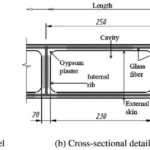
In the ever-evolving world of construction and architecture, new materials are constantly being developed to improve sustainability, energy efficiency, and the overall performance of buildings. One of the most promising innovations in recent years is hydroceramics – a type of ceramic material designed to interact with water and manage moisture in a way that benefits both the building and its occupants. In this blog, we’ll dive into the science of hydroceramics, their applications, and how they could revolutionize the construction industry.
What Are Hydroceramics?
Hydroceramics are a class of smart materials that can absorb, store, and release water in response to changes in environmental conditions, such as temperature and humidity. These materials are a combination of ceramic materials and hydrogel or hydrophilic substances, giving them the ability to manage moisture in innovative ways.
The primary feature of hydroceramics is their ability to regulate humidity and temperature within a building by utilizing the principles of water retention and evaporation. By integrating these materials into construction elements such as walls, tiles, and facades, hydroceramics can contribute to more energy-efficient buildings with improved indoor climates.
How Do Hydroceramics Work?
Hydroceramics function through their unique structure, which includes a porous network that can absorb water. When humidity levels rise, these materials absorb water into their pores, effectively storing it. When the humidity decreases, the water is released back into the environment, helping to maintain a stable and comfortable indoor environment.
The ability to regulate moisture not only enhances indoor comfort but can also improve the thermal performance of buildings. During hot weather, the release of stored water through evaporation cools the surrounding air, while in cold weather, hydroceramics can help reduce heat loss by absorbing moisture from the environment.
Applications in Building Design
- Energy Efficiency and Temperature Regulation: Hydroceramics are particularly valuable in passive building designs. By absorbing and releasing moisture, these materials can help regulate indoor temperatures, reducing the need for air conditioning or heating. This contributes to a building’s overall energy efficiency and lowers the carbon footprint.
- Improved Indoor Air Quality: By managing humidity levels, hydroceramics can help prevent the growth of mold and mildew, which thrive in damp environments. This is particularly beneficial in spaces such as bathrooms, kitchens, and basements, where moisture accumulation is common.
- Sustainability in Construction: As the construction industry moves toward more sustainable practices, materials like hydroceramics that help conserve energy and reduce the need for artificial climate control are gaining traction. These materials are often made from natural components, reducing their environmental impact.
- Design Aesthetics: Beyond their functional benefits, hydroceramic materials can be used in building design to create aesthetically pleasing surfaces, such as wall panels or tiles, that change in appearance as they interact with moisture. This could lead to dynamic, ever-changing facades and interiors that are not only functional but visually appealing.
The Future of Hydroceramics
The development of hydroceramics is still in its early stages, but their potential in the construction and design industries is vast. As research progresses, we can expect to see more advanced formulations of hydroceramic materials, with improved moisture absorption and release capabilities. Additionally, innovations in 3D printing and nanotechnology may allow for more precise control over the structure of hydroceramics, leading to even greater customization and functionality.
In the future, hydroceramics could become an essential component in sustainable building practices, contributing to the development of energy-efficient, resilient, and comfortable living and working environments.





